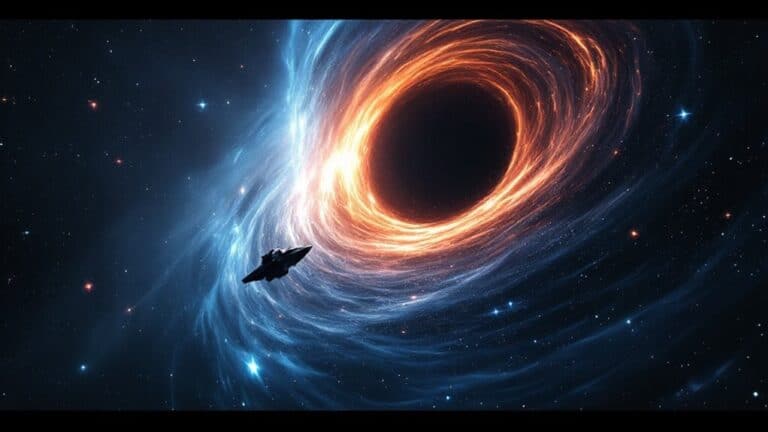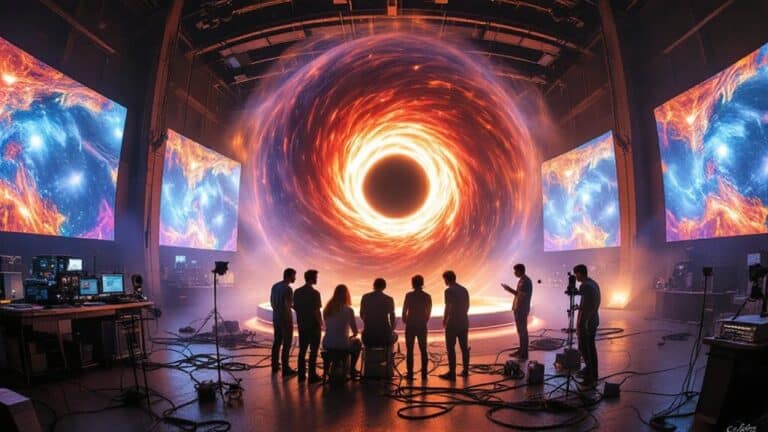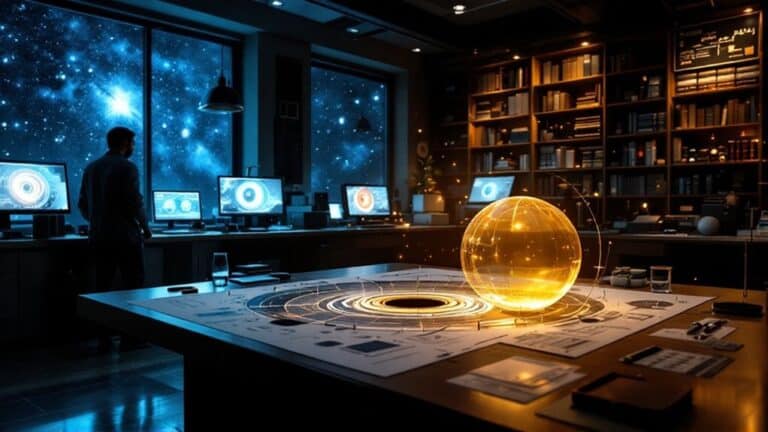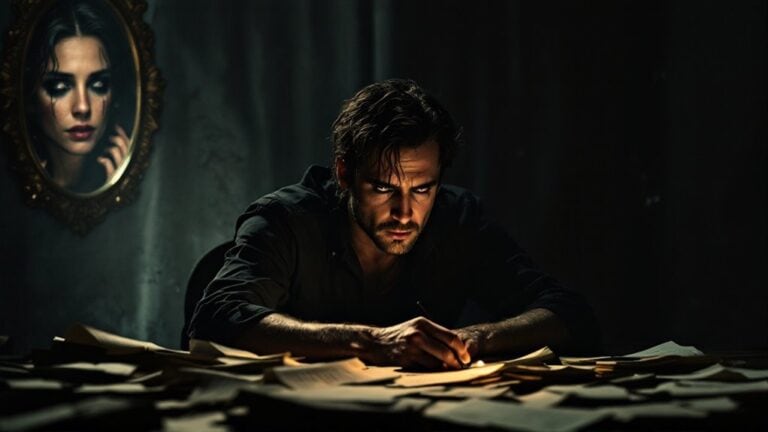The Emotional Power of Interstellar’s Cinematography: A Frame-by-Frame Analysis
*Interstellar’s* cinematography captures profound emotion through its innovative techniques and visual storytelling. Close-up shots draw you into characters’ intimate moments, while low-angle frames instill a sense of authority or threat. The vastness of space, highlighted by wide shots, evokes feelings of isolation, enhancing your emotional engagement. Dynamic lighting deepens the narrative, and the blending of practical effects with advanced CGI reinforces a realistic atmosphere. Each frame is a meticulous composition that invites reflection on universal themes of struggle and connection. This thoughtful design not only resonates with you but also pushes boundaries in cinematic expression, revealing much more beneath the surface.
Table of Contents
Key Takeaways
- Close-up shots in *Interstellar* foster intimacy, allowing viewers to connect deeply with characters’ emotional struggles and journeys.
- Non-linear storytelling intertwines timelines, creating anticipation and enhancing emotional resonance throughout the film.
- Dynamic camera techniques, such as shaky handheld shots, immerse viewers in chaotic moments, heightening emotional engagement.
- Symbolism in visuals, like spacecraft against the vast void, evokes feelings of isolation, reflecting universal human experiences.
- The use of practical effects coupled with innovative cinematography enhances realism, deepening the emotional impact on the audience.
Cinematic Techniques for Emotion
In filmmaking, the way emotions are conveyed can make all the difference in how a story resonates with its audience. One powerful way to achieve this is through shot composition. For instance, close-up shots draw you in, allowing you to connect intimately with a character’s emotions. When you see their facial expressions, you can feel their joy, pain, or fear more deeply.
Similarly, low-angle shots can instill a sense of authority or threat, while high-angle shots can evoke vulnerability, shifting your perspective as the viewer. The Rule of Thirds enhances visual interest and guides the viewer’s gaze, making the emotional impact of each shot even more profound. Mastery of shot composition impacts emotional depth in storytelling, with techniques like the rule of thirds and leading lines guiding viewer attention. Effective storytelling relies on a range of contrasts in emotional presentation, heightening the audience’s experience.
Lighting techniques also play a significant role in shaping emotional responses. Dynamic lighting creates mood, casting shadows that add depth to a scene. Warm colors, like reds and oranges, radiate passion and energy, pulling you into the moment. In contrast, cool colors evoke calmness or sadness, subtly influencing your feelings.
The interplay of bright and dark areas can emphasize key elements, guiding your emotional focus. Together, these cinematic techniques create a rich tapestry of emotion, helping you feel connected to the characters and their journeys.
This craft is what makes films like “Interstellar” resonate on a profound level, inviting you to explore the depths of human experience.
Visual Authenticity and Influence
Cinematic techniques not only shape emotional experiences but also establish a film’s authenticity and credibility. “Interstellar” achieves a striking visual authenticity through its large-format IMAX cinematography, which adds a tangible quality to the expansive universe it depicts. By using visual realism, the film immerses you in a world that feels both vast and intimately relatable.
Collaboration with physicist Kip Thorne guarantees that the depiction of space phenomena resonates with scientific precision, further solidifying its credibility. This partnership ensures that the film’s portrayal of black hole physics remains engaging while maintaining accuracy, particularly with the depiction of Gargantua’s mass being 100 million times that of the Sun.
The film pays a cinematic homage to classic space films like *2001: A Space Odyssey*, blending sweeping compositions with a documentary-inspired aesthetic. This approach creates a tactile nature, inviting you to feel the weight of both the cosmos and human emotion. Additionally, the use of wide shots in the film effectively conveys the vastness of space, enhancing the sense of isolation experienced by the characters.
Practical effects and real-world models enhance this authenticity, grounding the extraordinary in the familiar.
The juxtaposition of cosmic landscapes with intimate close-ups emphasizes humanity’s vulnerability amidst the universe’s grandeur. As you experience those moments, you’re reminded of the emotional depth that connects us all.
Ultimately, “Interstellar” not only captivates visually but also resonates on a profound level, inviting you to reflect on your place in the universe.
Emotional Storytelling Through Cinematography

Often, emotional storytelling in “Interstellar” hinges on its innovative use of cinematography to forge deep connections between the audience and characters. The film employs non-linear storytelling, intertwining various timelines that create anticipation and suspense. This technique enhances emotional resonance, allowing you to empathize with the characters’ journeys.
Dynamic camera techniques, such as shaky handheld shots, immerse you in the characters’ emotional states, making their struggles feel immediate and real. In contrast, tracking shots convey stability, grounding you in moments of calm amid chaos. The deliberate panning and tilting direct your attention to key elements, emphasizing their significance and evoking profound emotional responses. Effective pacing is crucial, as it allows the film to build tension and release it at the right moments, further engaging your emotions. Additionally, the use of IMAX camera in flight scenes creates a unique viewpoint that enhances the viewer’s sense of immersion and connection to the characters’ plight.
Color grading plays a pivotal role, establishing a visual atmosphere that amplifies the mood. As you watch, the meticulous framing guides your emotional journey, guaranteeing you feel the weight of each moment.
Symbolism and visual metaphors add layers of meaning, inviting deeper reflection on the characters’ emotional challenges. In “Interstellar,” every cinematographic choice enhances character empathy, connecting you to a narrative that resonates on a personal level, reminding you of your own emotional experiences.
This powerful blend of techniques guarantees you’re not just a viewer; you become part of the story.
Visual Effects and Scientific Accuracy
“Interstellar” stands out for its groundbreaking visual effects and scientific accuracy, merging stunning imagery with theoretical physics. The film’s commitment to visual realism makes it not just a cinematic experience but a journey through the cosmos that feels tangible and authentic. You might appreciate how the collaboration between director Christopher Nolan and physicist Kip Thorne created visuals that resonate with real-world science.
Here are some key aspects that enhance this connection:
- Advanced CGI techniques and simulations generated breathtaking visuals.
- The use of large-format IMAX cinematography immerses you in the intergalactic journey.
- Practical effects were favored over CGI, echoing the artistry of “2001: A Space Odyssey.”
- Authenticity was achieved by studying NASA footage and space documentaries.
The depiction of the black hole Gargantua, based on Thorne’s equations, showcases how deeply intertwined visual effects and scientific accuracy can be. This attention to detail in representing complex scientific phenomena not only elevates the film’s artistic merit but also enriches your understanding of cosmic phenomena. By blending stunning visuals with scientific principles, “Interstellar” sets a high standard for future sci-fi films, inviting you to explore the universe with both wonder and curiosity. Additionally, the film’s visual storytelling has a longer shelf life compared to typical sci-fi films, which enhances its cultural impact. Furthermore, the film’s commitment to practical effects showcases Nolan’s dedication to realism, further immersing viewers in the space exploration narrative.
Cinematic Innovation
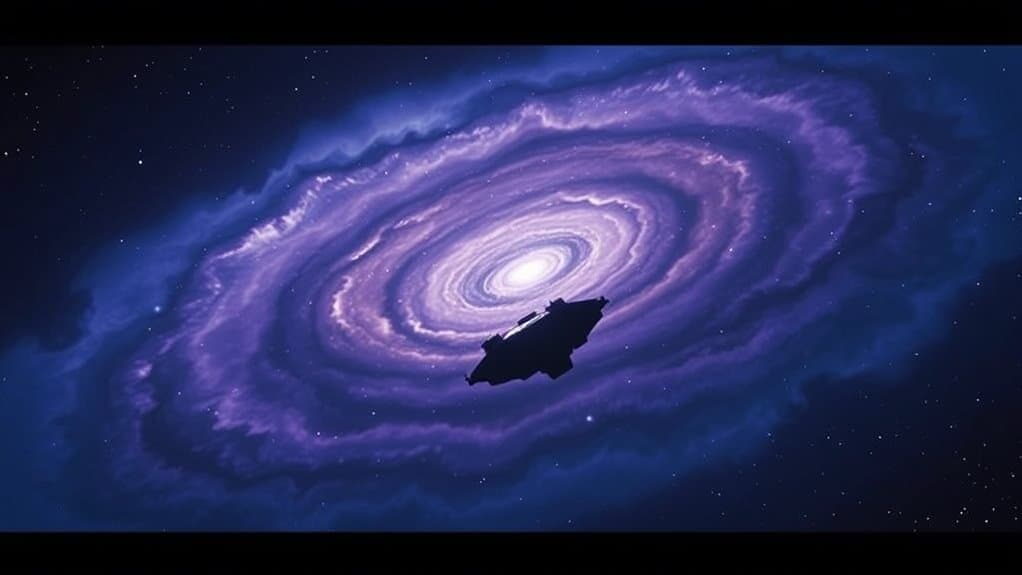
Multiple groundbreaking techniques define the innovation behind the film’s cinematography. You’ll notice how *Interstellar* masterfully utilizes IMAX and Vista Vision cameras to create a stunningly immersive experience, emphasizing space’s vastness. The choice of Hasselblad and Panavision lenses guarantees high-quality images, while the central and contrasting framing highlights the emotional depth of the characters and their struggles against the cosmic backdrop.
The film’s innovative use of lighting, blending practical effects with artificial enhancements, brings heightened realism to every scene. This choice not only creates stunning visuals but also amplifies the emotional weight of the narrative pacing. You can feel the tension build in moments of silence, allowing you to connect profoundly with the characters’ journeys. The use of shadows throughout the film creates depth and realism, further enhancing the connection to the story. The film’s exploration of humanity’s struggle for survival underscores the urgency of the characters’ emotional journeys and the stakes of their mission. Additionally, Hoyte van Hoytema’s signature style of using shallow depth of field allows for intimate portrayals of the characters, inviting viewers into their emotional experiences.
Visual symbolism permeates the film, as shots of spacecraft against the void evoke feelings of isolation and vulnerability. Each frame is carefully composed, inviting you to explore the delicate balance between humanity and the universe.
Christopher Nolan’s evolution as a filmmaker shines through, as he embraces longer moments that resonate emotionally, ultimately crafting a cinematic experience that stays with you long after the credits roll.
Impact on Cinematography and Science
Through a unique collaboration between filmmakers and scientists, *Interstellar* not only pushed the boundaries of cinematography but also made significant contributions to the field of science.
This film stands as a proof of the power of scientific collaboration and astrophysical inspiration, creating a visual narrative that resonates with both the heart and mind.
- The black hole Gargantua, meticulously designed using real physics equations, showcases the beauty of warped spacetime.
- Thorne’s involvement guaranteed that the film’s depiction of time dilation and the Penrose process sparked genuine interest in astrophysics, leading to the CGI team’s groundbreaking advancements in black hole modeling.
- The CGI team’s groundbreaking work led to real-world scientific validation, further blurring the lines between art and science.
- Academic papers inspired by *Interstellar* have emerged, driving new research and understanding of black holes.
Conclusion
To sum up, “Interstellar” masterfully intertwines stunning cinematography with profound emotional depth, like a symphony where every note resonates with the audience’s core. By employing innovative techniques and visual storytelling, it not only captivates viewers but also elevates the understanding of human experiences against the vastness of space. This film challenges conventional boundaries of cinematography, leaving an indelible mark on both cinematic art and our collective imagination, urging us to reflect on our place in the universe.


